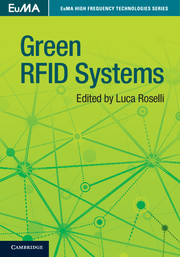Book contents
- Frontmatter
- Contents
- List of contributors
- Introduction
- 1 Context analysis
- 2 RFID background
- 3 Energy scavenging and storage for RFID systems
- 4 Technologies for RFID sensors and sensor tags
- 5 Unconventional RFID systems
- 6 Integrating tiny RFID- and NFC-based sensors with the Internet
- 7 Materials for substrates
- 8 Organic conductors and semiconductors: recent achievements and modeling
- 9 RFID enabling new solutions
- 10 Energy-efficient off-body communication using textile antennas
- Index
- References
4 - Technologies for RFID sensors and sensor tags
Published online by Cambridge University Press: 05 October 2014
- Frontmatter
- Contents
- List of contributors
- Introduction
- 1 Context analysis
- 2 RFID background
- 3 Energy scavenging and storage for RFID systems
- 4 Technologies for RFID sensors and sensor tags
- 5 Unconventional RFID systems
- 6 Integrating tiny RFID- and NFC-based sensors with the Internet
- 7 Materials for substrates
- 8 Organic conductors and semiconductors: recent achievements and modeling
- 9 RFID enabling new solutions
- 10 Energy-efficient off-body communication using textile antennas
- Index
- References
Summary
RFID sensor concept and constraints
RFID sensor architecture
During the previous decades RFID systems have infiltrated the market for various everyday uses. The systems are used for access control, mass transit ticketing, and baggage tagging to name a few. So far most of the systems only include a unique ID for identification or have a small amount of memory included on the tag. The next step forward for RFID systems is the availability of information about the environment of the tag. On the one hand this includes the position of the tag, on the other hand sensor values like temperature, humidity, or pressure are of interest.
RFID systems are made up of one or more RFID interrogators/readers and numerous passive RFID tags, see Figure 4.1. For communication with the tag, the reader generates a high-frequency modulated electromagnetic field. The tag receives the information modulated in the field and it can answer to the request from the reader with a back-scatter operation, i.e. the reflection coefficient is changed with respect to the requested information. In addition to the transmission of information between the tag and the reader, the tag can receive the necessary energy for operation from the electromagnetic field of the reader.
Active and passive RFID tags
Due to a wide range of application scenarios in this field, there exists a multitude of different sensor nodes. The most widespread developments have active sensor nodes, i.e. sensor nodes with their own energy supply, e.g. with a battery, and are for high performance and/or high range use cases [1].
As opposed to this, passive RFID tags use the ambient energy for their power supply.
Typically the basis of the received wireless power on the rectification is the energy-harvesting approach. Thus, for low cost and maintenance-free operation, passive RFID tags are well suited. Other approaches work with thermal or mechanical energy harvesting.
- Type
- Chapter
- Information
- Green RFID Systems , pp. 76 - 115Publisher: Cambridge University PressPrint publication year: 2014
References
- 1
- Cited by



